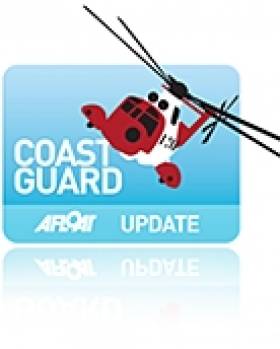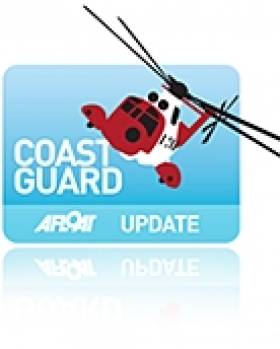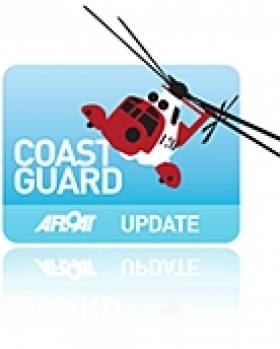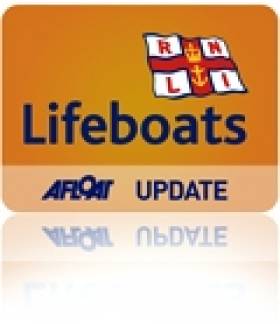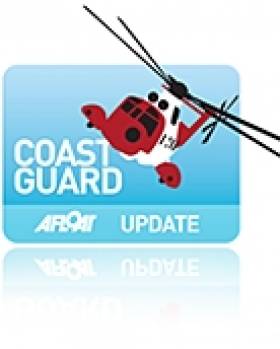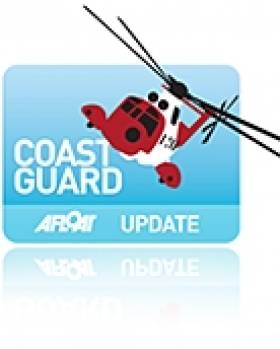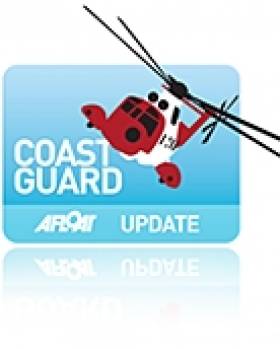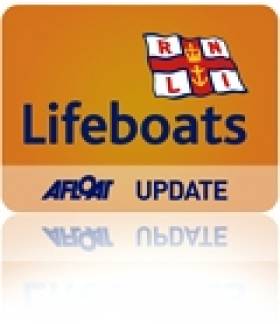Displaying items by tag: Coastguard
Passenger Vessel Evacuated off Welsh Coast
At 12.55pm today Milford Haven Coastguard received a mayday call from the passenger vessel Lady Helen, with 48 people on board reporting that they had run aground near Skomer Island and were taking in water.
Milford Haven Coastguard contacted other vessels in the area by radio and requested Angle and St Davids RNLI lifeboats to attend and the rescue helicopter from RAF Chivenor. The passengers were evacuated to other vessels and have been transferred to shore safely where they were met by Broadhaven and Dale Coastguard Rescue Teams. There were no injuries to passengers or crew.
The casualty vessel Lady Helen was re-floated and pumps have been put aboard to control the ingress of water. The vessel has gone undertow to Martins Haven.
#Coastguard - The Irish Coast Guard may lead open-sea searches for American space bosses when manned space flights resume, according to the Irish Examiner.
Coastguard chiefs have reportedly been in informal discussions with a senior official from Nasa regarding search and rescue procedures should a manned capsule come down in the North Atlantic.
Nasa's planned launch trajectory for rockets to the ISS or the moon, scheduled to resume in 2016, passes the south coast of Ireland within range of the new Shannon-based helicopter Rescue 115.
This means that if a Nasa vehicle were to ditch in those waters, the Irish Coast Guard would take the lead in any search and rescue effort.
The Irish Examiner has much more on the story HERE.
Fishing Vessel Owners Plead Guilty to Failing to Ensure Crew Held Appropriate Safety Certs
During a fishing trip in the Irish Sea on 27th January 2012, the United Kingdom registered fishing vessel Zenith, port letters B470 was hauling nets, when Andrius Kalinda (now known to be Nikolai Nedoliz) fell into the sea and was drowned. None of the crew was wearing life jackets at the time.
The MCA investigation found that two crew members including the deceased did not hold all of the required safety training certificates. Two of the crew held no safety training certificates at all.
The owners of the vessel, John More (57) and David Campbell (50) pleaded guilty at Downpatrick Magistrates Court on Wednesday 8th May 2013 to breaching the Fishing Vessels (Safety Training) Regulations 1989 section 2 and each was fined £1,250.00 plus £75.00 costs.
On summing up the Magistrate said: you had a serious responsibility to the crew to ensure that they were properly trained.
Captain Bill Bennett Area Operations Manager (Survey and Inspection) Northern Ireland for the MCA stated that:-
"Ensuring that fishermen undertake safety training has been an ongoing issue for many years. The safety Training Regulations came into force in 1989. The safety record within the industry as a whole is still far from satisfactory. Where the regulations are breached the MCA will investigate and where appropriate persons will be prosecuted.
#RNLI - Kilrush RNLI lifeboat station was put on standby on Monday 29 April for an aircraft with engine trouble, and later called to a person who drove into the water.
At 2pm on Monday the Irish Coast Guard at Shannon alerted the station authorities that there was a private aircraft descending in the region of the River Shannon with engine problems. It was reported that there were four people on board.
After a half an hour the lifeboat crew were informed the plane made a safe landing at Shannon Airport and the station was stood down.
Later that day at 8.47pm pagers were activated by the coastguard in Shannon to alert the crew that a person was reported to have driven off the road into the water in the area of Labasheeda, about nine nautical miles from Kilrush.
The lifeboat crew assembled and within eight minutes were launched and on their way to this area. Conditions on this evening were most favourable.
After five minutes they were stood down as members of the local Gardai had managed to rescue the driver and bring him ashore. An ambulance was standing by at this area to assist the casualty and team of helpers.
Kilrush lifeboat operations manager John Lamb praised the speed of the crew and the efficiency on which the launch took place.
“At times like these it’s always good to know that our team are trained to the highest standards to deal with callouts such as this evening,” he said.
In other news, President Michael D Higgins will pay a special call to Courtmacsherry RNLI lifeboat station this weekend during an official visit to the Cork village.
While there he will view an impressive historical exhibition which is running all through the May bank holiday weekend.
The exhibition, which has been planned for months, will have a strong emphasis on the lifeboat and its crew with most families in the village having had loved ones serving as volunteer lifeboat crew since 1825.
To mark this fact, local families have displayed the name of that lifeboat crew member outside their home and placed a pair of wellington boots on their doorstep. The yellow lifeboat boot is an iconic piece of the RNLI crew members' kit.
President Higgins is expected to arrive in Courtmacsherry at 4pm on Sunday 5 May and will first visit the lifeboat station where he will be met by volunteer lifeboat crew past and present and members of the station management and fundraisers.
The station has a proud history of lifesaving with 14 awards for gallantry.
Courtmacsherry RNLI launched after the sinking of the Lusitania in 1915 when the lifeboat crew rowed for over three hours in a desperate bid to reach survivors from the torpedoed vessel off the Old Head of Kinsale.
And during the Fastnet Race tragedy of 1979, in which 15 sailors lost their lives, the Courtmacsherry lifeboat was among of group of RNLI boats that spent 75 hours at sea in 60-knot winds.
The Norwegian coastguard have taken over the hunt for a missing Dutch sailing ship which has vanished with a crew of three on board.
The Warnow was apparently heading for Norway from Scotland and should have arrived on April 22 but nothing has been heard from the ship for two weeks.
Norwegian coastguards are using helicopters with special sensors in an effort to locate the ship. Officials in Sweden, Denmark and Germany have also been warned to be on the alert for internet signals, Dutch media reported.
A spokesman for the Dutch coastguard said the final destination of the ship is unknown and it was believed to be heading for the Northern Lights.
More from: www.dutchnews.nl/news/
Howth Coast Guard Trains With Irish Red Cross
#Coastguard - Howth Coast Guard has blogged about its recent medical exercise with the Irish Red Cross.
The multi-casualty medical training exercise involved lowering a number of qualified and trainee emergency medical technicians (EMTs) into Whitewater Brook by the heights rescue team.
These EMTs served as serious trauma victims who were then retrieved through the joint effort of over 40 personnel between the two organisations who worked together to triage, treat and evacuate.
Another recent training exercise, as featured in the video above, involved the safe evacuation of a casualty with a lower limb fracture.
"One of the more common callouts we receive are for people enjoying walking or running in the area who slip and fracture a lower limb or ankle injury," said the North Dublin-based unit of the Irish Coast Guard.
"The team regularly train for this scenario, ensuring all members are able to stabilise, package, and evacuate by stretcher a casualty in this situation."
#coastguard – Minister for Transport, Tourism & Sport Leo Varadkar has welcomed the opening of a new state-of-the-art Irish Coast Guard facility at Crosshaven in Co. Cork.
The purpose-built facility was developed by the Department of Transport, Tourism & Sport and the OPW to provide a modern base for Crosshaven Volunteer Coast Guard Unit, as well as a Coast Guard Regional HQ and Training centre. The building can also serve as an emergency management co-ordination centre for use by other statutory services.
Minister Varadkar said: 'The Crosshaven team is made up of 20 local volunteer members and I am delighted to have this opportunity to thank them for their dedication and hard work. They train every week and provide weekly for a 24 hour, seven day emergency response to shoreline and coastal emergencies. I also want to congratulate the volunteers who today received their long-service medals. They are richly deserved'.
The new station was officially opened on behalf of the Government by Minister for Agriculture, Food and the Marine Simon Coveney, who also presented long service medals to volunteers drawn from local Coast Guard Units. Following the ceremony a Coast Guard helicopter landed in the vicinity of the station, affording members of the public an opportunity to view the helicopter and to meet the crew.
The largest element of the Crosshaven building is the boathouse or garage area, which is fitted with large roller shutter doors to allow for the rapid response of vehicles and boats. The upper level has an operations room, office and training room.
Busy Saturday for RNLI on Lough Derg
#RNLI - Lough Derg RNLI launched twice yesterday (21 April) on consecutive callouts to a vessel grounded at the Corrakeen Islands and a sinking cruiser at the northern end of the lake.
Around 3.45pm yesterday, Valentia Coast Guard requested the launch of the Lough Derg RNLI lifeboat to assist three people on board their 20ft cruiser after their engine failed and were pushed on to rocks by the Corrakeen Islands in Dromineer Bay.
Helm Eleanor Hooker with Ger Egan and Tom Dunne set out in winds blowing south westerly, force 3 and gusting 5, and the lifeboat was alongside within half an hour of launch.
The two adults and a young child on board were unharmed but extremely anxious. They had dropped anchor to prevent further grounding and breakage.
An RNLI crew member was transferred to their boat to assess for damage and, very quickly - once it was established that the vessel was not holed - set up for a tow, weighed anchor and the lifeboat took them off the rocks and out into safe water.
The lifeboat then towed the boat with her crew (and the RNLI volunteer still on board) to Dromineer Harbour, where RNLI shore crew were waiting to take lines and help.
Lough Derg RNLI crew member Ger Egan advised that said anyone taking their boat afloat after the long winter should "make sure that their engines are fully serviced and make sure to use new fresh fuel".
Later that afternoon the lifeboat launched again to assist two people who had taken to their liferaft as their cruiser was sinking.
The exact location of the 28f cruiser was not certain, but once the lifeboat crew were informed that the cruiser had set out from Terryglass at the northern end of the lake, an half hour earlier they were able to accurately estimate the liferaft’s current location.
At 5.50pm the lifeboat launched with helm Eleanor Hooker, Peter Clake and David Moore on board. Winds were south westerly, force 4, gusting 6.
The lifeboat located the cruiser and the liferaft north of Coolbawn, south of Gortmore, on the eastern shore of Lough Derg, and was alongside by 6.15pm, The two people on board were unharmed, but the skipper was greatly distressed.
He had inadvertently veered off course and had glanced off a rock and holed his boat. A passing 18ft speedboat with two people on board also came alongside and gave assistance.
Two lifeboat crew members helped the people from the liferaft and onto the speedboat, which had a canopy and offered shelter from the wind. They gathered the liferaft and its contents into the cruiser cabin and, as the cruiser was rapidly taking water, they weighed anchor so that the lifeboat could beach the vessel and reduce risk of further damage.
Once beached, the lifeboat crew dropped anchor once more, and especially as the winds were forecast to get up in the night. There was no evidence of fuel leakage and arrangements were made for the vessel to assessed and recovered this morning.
The lifeboat and the speedboat, with the two casualties on board and under cover, then made way to Garrykennedy where friends were waiting to look after them.
Eleanor Hooker thanked Cillian Boyle, the helm of the speedboat, for his kind assistance and commended her crew for their "kind consideration of the casualties and their calm professionalism in dealing with the fraught situation".
Ireland-Bound French Yachts Avoid Danger Off Dorset
#Offshore - A fleet of 20 French yachts racing to Ireland narrowly avoided sailing into serious trouble off the Dorset coast earlier this week.
As BBC News reports, UK coastguard authorities scrambled to warn the yachts via emergency broadcast that they were headed towards an exclusion zone set up for a live firing exercise at Lulworth Ranges.
"It looks like there was a slight error made by the French authorities," said a coastguard spokesperson, who confirmed that the yachts were diverted from their dangerous course after contacting the race director.
According to Practical Boat Owner, the yachts were competing in the Normandy Channel Race which began on Sunday 14 April and continues till this Friday evening.
The race route to and from Caen in northern France traverses a triangle across the Celtic Sea, past the most southwesterly tip of Cornwall, via Tuskar Rock and Fastnet Rock.
Howth Coast Guard Assists Powerless Boat In Drogheda
#Coastguard - The Howth unit of the the Irish Coast Guard responded this weekend to a vessel that lost power at the mouth of the River Boyne.
Howth's coastguard crew were undertaking helm training with a passage to the Drogheda unit to support the Drogheda Marina launch when they were notified that a ski-boat planning to join the flotilla had lost power on the Drogheda Bar.
The vessel, with four people aboard, was taken under tow - while a mother and child on a second vessel suffering from serious sea-sickness were also transferred to the coastguard boat.
As previously reported on Afloat.ie, the Drogheda Port Company undertook dredging works in January this year on the entrance to the port on the River Boyle, following earlier works in 2010 to remove sand accumulating at Drogheda Bar.


























